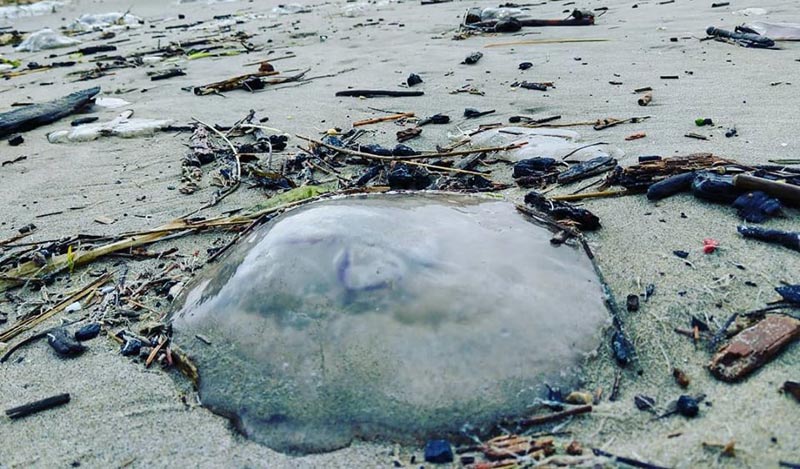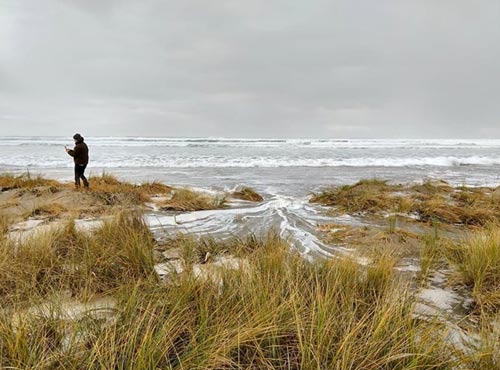Moon Jellies Over Manzanita: Tides Bring Translucent Finds to Oregon Coast
Published 12/31/2019 at 5:55 PM PDT
By Oregon Coast Beach Connection staff

Includes exclusive listings; some specials in winter
In Cannon Beach:
Includes rentals not listed anywhere else
In Manzanita, Wheeler, Rockaway Beach:
Some specials for winter
In Pacific City, Oceanside:
Some specials for winter
In Lincoln City:
Some specials for winter
In Depoe Bay, Gleneden Beach:
Some specials for winter
In Newport:
Look for some specials
In Waldport
Some specials for winter
In Yachats, Florence
Some specials for winter
(Manzanita, Oregon) – Christmas brought in a different kind of present to the Oregon coast, as the king tides battered the beaches and surges caused the ocean to cough up some funky finds. Among the discoveries: hordes of moon jellies, especially in the Manzanita area. (All photos courtesy Ginger Edwards of North Fork 53.)
Those king tides also brought some unusual sights to the area, all captured by Ginger Edwards of Nehalem lodging North Fork 53.
Considering the current state of tides along the entire Oregon coast and Washington coast, you can probably look for weird beach finds as soon as this run of tidal surges is done as well. The post-holiday weekend should be a great one for beachcombing in places like Gold Beach, Bandon, Newport, Oceanside, Warrenton or Moclips, Washington.
Edwards caught some amazing high tide action in the Manzanita area last week, showing waves right up to the vegetation line – which is normally about 100 feet or more from the tideline.
Even more remarkably, hordes of moon jellies were dotting the beaches, and in a way Edwards said she had not seen before.
“They were pretty much everywhere,” she said. “I've never seen them washed that far up into the dune grasses and willow trees near Ocean Ave. They are normally 50-60 feet below that line. It was highly unusual but cool to see. “
Edwards estimated there were areas of 10 feet by 10 feet with some of them packed inside, but largely they were strewn all over the place.
Moon jellies are usually about a a foot in diameter when they make landfall on Washington and Oregon beaches, with sizes varying a bit from smaller than that to just slightly larger. They are one of about ten jellyfish that are very similar, often making it hard to discern one species from the other.

The translucent, rather surreal moon jelly is an odd creature by most standards, but not so much in the context of ocean life, where all bets are off when it comes to normality for this planet. They are known by the name Aurelia aurita, and they have no bones nor brains, which is common for jellyfish.

According to Tiffany Boothe of Seaside Aquarium, they range from Alaska to California and are basically “drifters” that don’t have a way of propelling themselves and are simply at the whim of ocean currents.
“They eat tiny marine life such as plankton and diatoms, which they pick up with the tiny hair-like tentacles that lace the outside edge of the jellyfish,” Boothe said. “Though they sting their prey, us large, thick-skinned humans cannot be harmed by this jelly.”
Boothe said you can’t even feel their stingers. This is probably a good thing, considering the moon jellies literally do not have a heart either.

They are common off the Oregon coast but are more so in tropical climates, able to live in a wide range of temperatures.
How they breathe is also a curiosity. Moon jellies do not have breathing organs such as gills or lungs, but instead diffuse oxygen from water through a thin membrane.
After the stormy wave issues are over with, hit the beaches of both the Oregon and Washington coast and you’ll likely find gobs of interesting things. See The Staggering Beauty of an 'Ocean Burp' on Oregon Coast
Oregon Coast Hotels for this event - Where to eat - Map - Virtual Tour
Cannon Beach Lodging
Nehalem Bay Lodgings
Manzanita Hotels, Lodging
Three Capes Lodging
Pacific City Hotels, Lodging
Lincoln City Lodging
Depoe Bay Lodging
Newport Lodging
Waldport Lodging
Yachats Lodging
Oregon Coast Vacation Rentals
Oregon Coast Lodging Specials
More About Oregon Coast hotels, lodging.....
More About Oregon Coast Restaurants, Dining.....
LATEST Related Oregon Coast Articles
Through 2 a.m. likely best, but some lights possible through dawn June 1 - 2. Space weather, astronomy
Rare Sperm Whale Stranding on N. Oregon Coast, Was Hit by Boat
Showing up near Gearhart, it will decompose naturally. Marine sciences
Coast Guard Barque 'America's Tall Ship' Coming to Portland Rose Fest, N. Ore...
Portland events: June 5 - 8; Astoria events June 13 - 15. Weather
Bright and Active Arietids Meteors May Hit Pre-Dawn Hours of Oregon, Washingt...
Look to east hour before sunrise and you may catch a show. Sciences, astronomy, weather
Why Now Could Be a Great Week for Spotting Killer Whales on Oregon Coast - Video
A good dozen documentations around Depoe Bay, Newport, Coos Bay, Bandon, Tillamook. Marine sciences
Summer Road Work, Traffic Issues Along Oregon Coast Include Astoria, Garibald...
Some daylight closures include bridges, OR 22, OR 18, OR 26, more. Travel tips. Seaside, Cannon Beach, Lincoln City. Travel tips
Pacific City Oregon Weather, 7-Day Forecasts, Live Conditions, Radar, Webcams...
Updated Constantly: Pacific City, Tierra Del Mar, Oregon Weather, Cams, Buoy Observations, Tides, Warnings - Alerts
Oregon Coast Has World's Oldest Harbor Seal, Celebrating 50 Years Soon
June 3 at Oregon Coast Aquarium in Newport. Newport events
Back to Oregon Coast
Contact Advertise on BeachConnection.net
All Content, unless otherwise attributed, copyright BeachConnection.net Unauthorized use or publication is not permitted















































